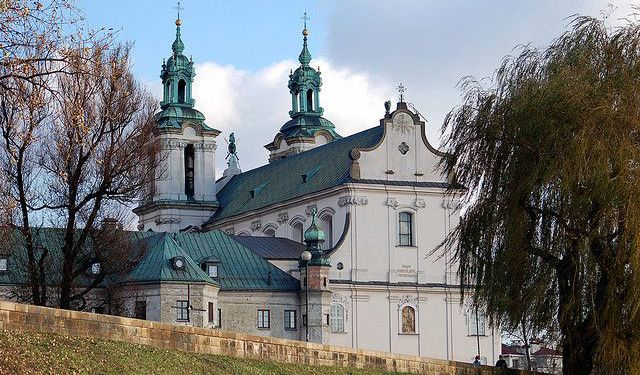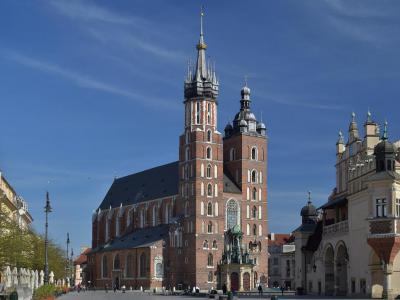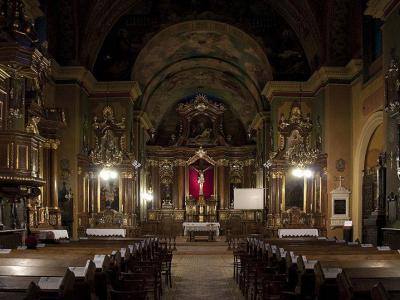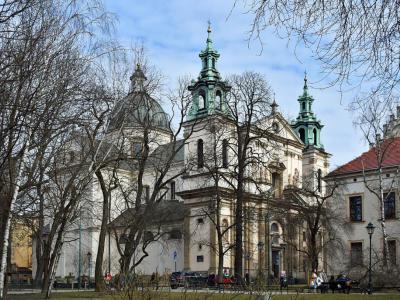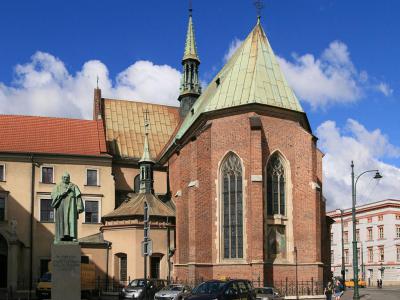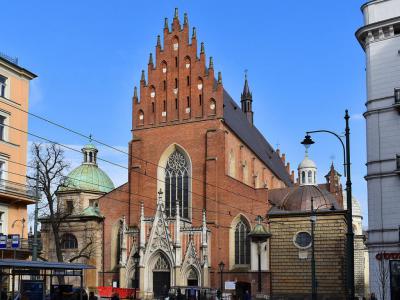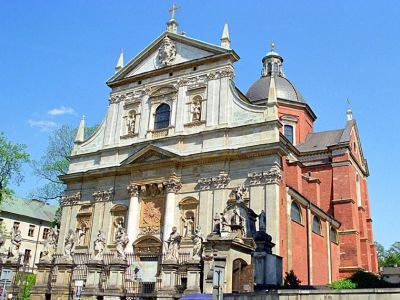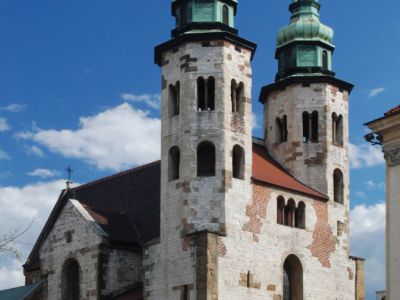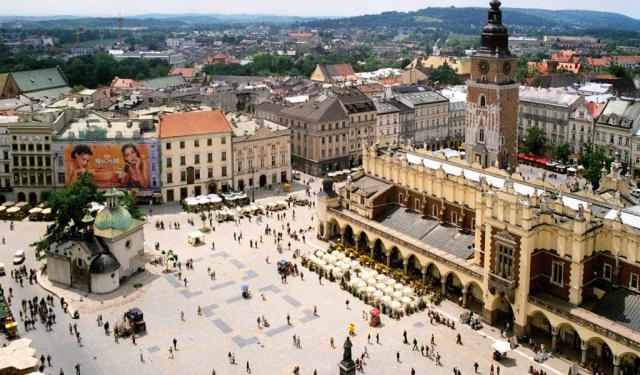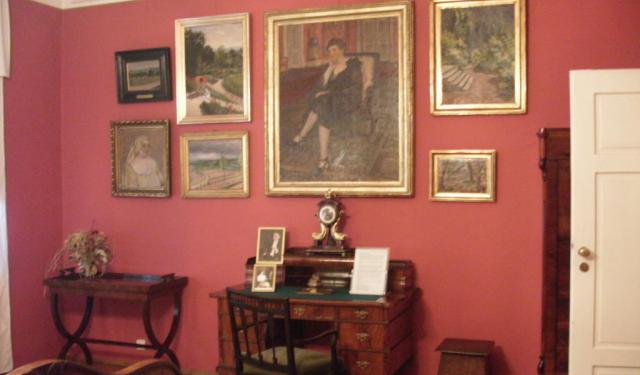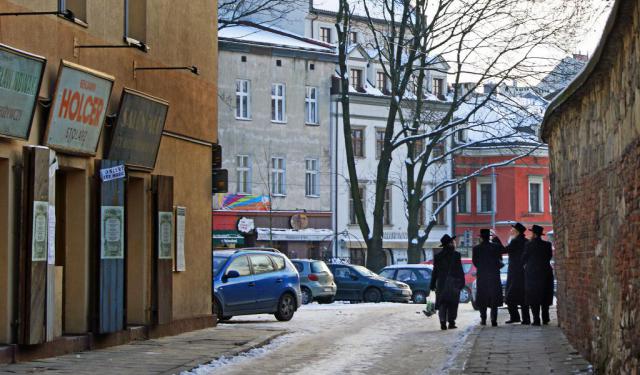Historical Churches Walking Tour (Self Guided), Krakow
Krakow, the center of religious life in Poland, was once considered “the Northern Rome” for its multitude of churches. Alongside the new temples continuing to appear in the city today, these remarkable sanctuaries, holding deep historical and cultural significance, still remain the most attractive and interesting to look at.
By far the most iconic of these is the Basilica of Saint Mary. A true symbol of Krakow, located in the heart of the Main Market Square, its stunning Gothic architecture and impressive altarpiece place it among the top tourist sights in the city.
Saint Casimir's Church, dedicated to one of the patron saints of Poland, is another notable religious site. It boasts a Baroque interior adorned with exquisite frescoes and sculptures, offering a glimpse into the city's artistic past.
Also renowned for its Baroque design, and picturesque façade, is the Church of Saint Anne. Inside, visitors can admire the intricate stucco decorations.
The Basilica of Saint Francis, with its modest yet elegant exterior, is an important religious center. It is associated with the Franciscan order and contains valuable religious art and artifacts.
The Basilica of Holy Trinity, situated in the Old Town district, is a testament to the city's diverse history. Gothic on the outside, it showcases a fusion of styles on the inside, including Baroque and Renaissance elements.
Saint Peter and Paul's Church, known for its two-color (red-and-white) façade, is a masterpiece of the early Baroque period. Its opulent interior and stunning frescoes are a sight to behold.
Finally, Saint Andrew's Church, a Romanesque gem, dates back to the 11th century. It is one of the oldest churches in Krakow, featuring a simple yet charming design.
Visiting these historical churches in Krakow not only provides insight into the city's rich religious past but also offers a chance to appreciate the artistic and architectural marvels that have stood the test of time. Checking out these acclaimed places of worship on our self-guided journey is bound to give you an enriching experience that connects you with the city's enduring spiritual legacy.
By far the most iconic of these is the Basilica of Saint Mary. A true symbol of Krakow, located in the heart of the Main Market Square, its stunning Gothic architecture and impressive altarpiece place it among the top tourist sights in the city.
Saint Casimir's Church, dedicated to one of the patron saints of Poland, is another notable religious site. It boasts a Baroque interior adorned with exquisite frescoes and sculptures, offering a glimpse into the city's artistic past.
Also renowned for its Baroque design, and picturesque façade, is the Church of Saint Anne. Inside, visitors can admire the intricate stucco decorations.
The Basilica of Saint Francis, with its modest yet elegant exterior, is an important religious center. It is associated with the Franciscan order and contains valuable religious art and artifacts.
The Basilica of Holy Trinity, situated in the Old Town district, is a testament to the city's diverse history. Gothic on the outside, it showcases a fusion of styles on the inside, including Baroque and Renaissance elements.
Saint Peter and Paul's Church, known for its two-color (red-and-white) façade, is a masterpiece of the early Baroque period. Its opulent interior and stunning frescoes are a sight to behold.
Finally, Saint Andrew's Church, a Romanesque gem, dates back to the 11th century. It is one of the oldest churches in Krakow, featuring a simple yet charming design.
Visiting these historical churches in Krakow not only provides insight into the city's rich religious past but also offers a chance to appreciate the artistic and architectural marvels that have stood the test of time. Checking out these acclaimed places of worship on our self-guided journey is bound to give you an enriching experience that connects you with the city's enduring spiritual legacy.
How it works: Download the app "GPSmyCity: Walks in 1K+ Cities" from Apple App Store or Google Play Store to your mobile phone or tablet. The app turns your mobile device into a personal tour guide and its built-in GPS navigation functions guide you from one tour stop to next. The app works offline, so no data plan is needed when traveling abroad.
Historical Churches Walking Tour Map
Guide Name: Historical Churches Walking Tour
Guide Location: Poland » Krakow (See other walking tours in Krakow)
Guide Type: Self-guided Walking Tour (Sightseeing)
# of Attractions: 7
Tour Duration: 1 Hour(s)
Travel Distance: 2.2 Km or 1.4 Miles
Author: ellen
Sight(s) Featured in This Guide:
Guide Location: Poland » Krakow (See other walking tours in Krakow)
Guide Type: Self-guided Walking Tour (Sightseeing)
# of Attractions: 7
Tour Duration: 1 Hour(s)
Travel Distance: 2.2 Km or 1.4 Miles
Author: ellen
Sight(s) Featured in This Guide:
- Basilica of St. Mary
- St. Casimir's Church
- Church of St. Anne
- Basilica of St. Francis
- Basilica of Holy Trinity
- St. Peter and St. Paul’s Church
- St. Andrew's Church
1) Basilica of St. Mary (must see)
Saint Mary's Basilica is one of the city’s most iconic landmarks, rising over the Main Market Square with its distinctive pair of uneven towers. Its history stretches back to the early 13th century, when the original church was built on the foundations of an even earlier Romanesque structure. After the Mongol invasion of 1241 left much of Kraków in ruins, the church was rebuilt in Gothic style, taking on its recognizable form. Over the following centuries, it became one of the most important religious and artistic centers in the city.
Once you find yourself in front of the church, you can clearly see that the left tower is the taller one. In terms of design, it is more intricate than the right one, and its helmet has sharper spires. As you step inside, you will notice the soaring vaulted ceiling painted a deep blue and dotted with gold stars, creating a cosmic effect that draws the eye upward. However, the church’s most celebrated treasure is the monumental wooden altarpiece carved by German sculptor Veit Stoss in the late 15th century. Even though it is visible as soon as you enter the church, its beauty is best admired up close. The famous altarpiece can be found under the chancel opening, which is marked by a huge cross. Considered one of the greatest Gothic sculptures in Europe, the altarpiece depicts scenes from the life of the Virgin Mary in extraordinary detail, with dozens of figures carved from linden wood and highlighted with bold colors and gold leaf.
Another highlight is the basilica’s stained-glass windows, including some of Poland’s finest examples of medieval and 19th-century glasswork. The most impressive windows can be observed behind and beside the Veit Stoss masterpiece. Moreover, richly decorated chapels line the nave, showcasing centuries of donations by wealthy patrons, guilds, and noble families.
Outside, the basilica’s taller tower reveals its more distinct function. From this tower, every hour, a trumpeter plays a brief melody that ends abruptly, commemorating a legendary trumpeter who was shot while warning the city of a Mongol attack. The live performance of this bugle call remains one of Kraków’s most beloved traditions. Don’t miss it.
Once you find yourself in front of the church, you can clearly see that the left tower is the taller one. In terms of design, it is more intricate than the right one, and its helmet has sharper spires. As you step inside, you will notice the soaring vaulted ceiling painted a deep blue and dotted with gold stars, creating a cosmic effect that draws the eye upward. However, the church’s most celebrated treasure is the monumental wooden altarpiece carved by German sculptor Veit Stoss in the late 15th century. Even though it is visible as soon as you enter the church, its beauty is best admired up close. The famous altarpiece can be found under the chancel opening, which is marked by a huge cross. Considered one of the greatest Gothic sculptures in Europe, the altarpiece depicts scenes from the life of the Virgin Mary in extraordinary detail, with dozens of figures carved from linden wood and highlighted with bold colors and gold leaf.
Another highlight is the basilica’s stained-glass windows, including some of Poland’s finest examples of medieval and 19th-century glasswork. The most impressive windows can be observed behind and beside the Veit Stoss masterpiece. Moreover, richly decorated chapels line the nave, showcasing centuries of donations by wealthy patrons, guilds, and noble families.
Outside, the basilica’s taller tower reveals its more distinct function. From this tower, every hour, a trumpeter plays a brief melody that ends abruptly, commemorating a legendary trumpeter who was shot while warning the city of a Mongol attack. The live performance of this bugle call remains one of Kraków’s most beloved traditions. Don’t miss it.
2) St. Casimir's Church
Standing quaintly in the Old Town District of Krakow is the Church of Saint Casimir the Prince. The plain white exterior may not look extraordinary but the church is quite unique in its own right. One of the most mysterious places in Krakow, it gets a number of visitors year-round waiting to steal a peek at the secrets that lie beneath it.
Adjacent to the Franciscan monastery, the church has over the years, managed to garner much curiosity from visitors all over the world. Established in the late 17th century, the church has been the final home for many locals, monks as well as members of the noble family. Although this may not seem like an extraordinary facet, it is this very quality that has popularized Saint Casimir's.
The catacombs are said to contain over 1000 bodies over the years, a quarter of which were monks and the rest belong to lay people. The unique climatic conditions in the crypts allow the bodies to undergo a natural process of mummification. Historians believe that the micro-climate of the catacombs arrests the decaying of the corpses that have been kept in the crypts since the 17th century.
Many corpses were laid in the catacombs without coffins and directly on earth. Among the mummies is the body of Countess Domicella Skalka who served the church as a housemaid for over 20 years and only revealed her true identity moments before her death.
Tip:
The monastic crypts with mummified bodies are made available for public viewing only once a year on All Souls Day (November 2nd), the day after All Saints Day.
Adjacent to the Franciscan monastery, the church has over the years, managed to garner much curiosity from visitors all over the world. Established in the late 17th century, the church has been the final home for many locals, monks as well as members of the noble family. Although this may not seem like an extraordinary facet, it is this very quality that has popularized Saint Casimir's.
The catacombs are said to contain over 1000 bodies over the years, a quarter of which were monks and the rest belong to lay people. The unique climatic conditions in the crypts allow the bodies to undergo a natural process of mummification. Historians believe that the micro-climate of the catacombs arrests the decaying of the corpses that have been kept in the crypts since the 17th century.
Many corpses were laid in the catacombs without coffins and directly on earth. Among the mummies is the body of Countess Domicella Skalka who served the church as a housemaid for over 20 years and only revealed her true identity moments before her death.
Tip:
The monastic crypts with mummified bodies are made available for public viewing only once a year on All Souls Day (November 2nd), the day after All Saints Day.
3) Church of St. Anne
Located on Saint Anny Street in Kraków, the Church of Saint Anne is a UNESCO-protected Roman Catholic building. An iconic example of Polish Baroque style, it was designed by Tylman van Gameren. Yet, the origins of this ecclesiastical monument trace back to the 14th century.
In 1381, records show the church's first mention under Sulisław I Nawoja of Grodziec's donation documentation. A fire destroyed the church in 1407, but it was rebuilt in Gothic style in the same year under King Władysław II Jagiełło's patronage. King Jagiełło also linked the church with Jagiellonian University, allowing it to appoint the parish priest. The choir was reconstructed and expanded in 1428. Saint Anne's became a collegiate church on October 27, 1535, through an official decree, marking its highest ecclesiastical achievement.
In 1689, the old Gothic structure was taken down as it couldn't support the increasing devotion to Saint John Cantius, the patron saint of Jagiellonian University. From 1689 to 1705, a new Baroque cathedral was built, influenced by Rome's Sant'Andrea della Valle. Tylman van Gameren, a Dutch architect integrated into Polish culture, led this under John III Sobieski's patronage.
The church's lavish interior features intricate stucco work by Baldassarre Fontana, complemented by captivating polychromatic elements from notable painters like the Monti brothers, Karl Dankwart of Nysa, and Jerzy Siemiginowski-Eleuter. The high altar showcases Siemiginowski-Eleuter's skill with a portrayal of Saint Anne. Szymon Czechowicz's 18th-century masterpieces adorn the stalls, depicting the life of Saint Anne. A cross-dedicated altar stands out in the transept's left, while John Cantius' sepulcher holds a solemn presence on the right.
In 1381, records show the church's first mention under Sulisław I Nawoja of Grodziec's donation documentation. A fire destroyed the church in 1407, but it was rebuilt in Gothic style in the same year under King Władysław II Jagiełło's patronage. King Jagiełło also linked the church with Jagiellonian University, allowing it to appoint the parish priest. The choir was reconstructed and expanded in 1428. Saint Anne's became a collegiate church on October 27, 1535, through an official decree, marking its highest ecclesiastical achievement.
In 1689, the old Gothic structure was taken down as it couldn't support the increasing devotion to Saint John Cantius, the patron saint of Jagiellonian University. From 1689 to 1705, a new Baroque cathedral was built, influenced by Rome's Sant'Andrea della Valle. Tylman van Gameren, a Dutch architect integrated into Polish culture, led this under John III Sobieski's patronage.
The church's lavish interior features intricate stucco work by Baldassarre Fontana, complemented by captivating polychromatic elements from notable painters like the Monti brothers, Karl Dankwart of Nysa, and Jerzy Siemiginowski-Eleuter. The high altar showcases Siemiginowski-Eleuter's skill with a portrayal of Saint Anne. Szymon Czechowicz's 18th-century masterpieces adorn the stalls, depicting the life of Saint Anne. A cross-dedicated altar stands out in the transept's left, while John Cantius' sepulcher holds a solemn presence on the right.
4) Basilica of St. Francis
The Basilica of St. Francis dates back to the early 13th century, when the Franciscan Order arrived in Kraków. The church was constructed between approximately 1237 and 1269 and consecrated around 1269. Over the centuries, the building has undergone many changes including expansions in the 15th century and a serious fire in 1850 that destroyed much of the interior prompting major restoration.
On the outside, the basilica retains a simple brick Gothic appearance typical of medieval Kraków buildings. Inside, however, it surprises visitors with a dramatic contrast: in the late 19th and early 20th centuries, the celebrated Polish artist Stanisław Wyspiański was commissioned to redecorate the walls and design stained-glass windows. His work transformed the church into one of the city’s most stunning expressions of Art Nouveau — floral and vegetal motifs wrap around the choir and transept while ceilings are dotted with stars and several stained-glass windows filter light in vivid colours. Among them, the most famous window depicts God the Father raising the world; it can be found at the western end of the nave, above the main entrance. It is best seen at the midpoint between the entrance and the main altar.
This blend of medieval structure and colourful, almost dreamlike interior makes the basilica especially compelling. On sunny days, rays passing through the stained glass cast shifting patterns inside, enhancing the contemplative atmosphere. Beyond its art, the basilica holds deeper historical and spiritual resonance: it is the resting place of the medieval nobleman Bolesław V the Chaste (one of its early patrons) and his sister, Blessed Salomea of Kraków.
Another noteworthy feature is a certified copy of the Shroud of Turin, displayed in a side chapel (known as the Passion of Christ Chapel). As you enter the church, it is the first major chapel on the right. The replica of the Shroud is usually displayed on the chapel's inner wall, though the Shroud's position in the chapel can vary temporarily.
The basilica is located within the Old Town, not far from the historic main square. Visiting it offers a quiet — often overlooked — but deeply rewarding experience. It is not surprising that St. Francis was the first church visited by Pope John Paul II upon arriving in Kraków.
On the outside, the basilica retains a simple brick Gothic appearance typical of medieval Kraków buildings. Inside, however, it surprises visitors with a dramatic contrast: in the late 19th and early 20th centuries, the celebrated Polish artist Stanisław Wyspiański was commissioned to redecorate the walls and design stained-glass windows. His work transformed the church into one of the city’s most stunning expressions of Art Nouveau — floral and vegetal motifs wrap around the choir and transept while ceilings are dotted with stars and several stained-glass windows filter light in vivid colours. Among them, the most famous window depicts God the Father raising the world; it can be found at the western end of the nave, above the main entrance. It is best seen at the midpoint between the entrance and the main altar.
This blend of medieval structure and colourful, almost dreamlike interior makes the basilica especially compelling. On sunny days, rays passing through the stained glass cast shifting patterns inside, enhancing the contemplative atmosphere. Beyond its art, the basilica holds deeper historical and spiritual resonance: it is the resting place of the medieval nobleman Bolesław V the Chaste (one of its early patrons) and his sister, Blessed Salomea of Kraków.
Another noteworthy feature is a certified copy of the Shroud of Turin, displayed in a side chapel (known as the Passion of Christ Chapel). As you enter the church, it is the first major chapel on the right. The replica of the Shroud is usually displayed on the chapel's inner wall, though the Shroud's position in the chapel can vary temporarily.
The basilica is located within the Old Town, not far from the historic main square. Visiting it offers a quiet — often overlooked — but deeply rewarding experience. It is not surprising that St. Francis was the first church visited by Pope John Paul II upon arriving in Kraków.
5) Basilica of Holy Trinity
Presiding over the vicinity in its Gothic grandeur is the large Dominican temple, known as the Basilica of Holy Trinity. Ever since established in the mid-13th century, this church has been the stronghold of the Black Friar brotherhood in Krakow. In 1850 the building suffered severe damage from fire that had claimed one-tenth of the city. Sadly, the ensued reconstruction didn't do a particularly good job on the original, leaving behind traces visible today, albeit not to an untrained eye.
The Dominican friary adjoining the Basilica was founded by Saint Jacek Odrowaz, who is widely known internationally as San Jacinto. He died in Krakow in 1257 and his relics are enshrined in an upstairs sanctuary-chapel.
In 1289 Duke Leszek II the Black, the then ruler of Poland, was also interred in the temple, next to the high altar. Over the next few centuries, the Holy Trinity church had served as a resting place for many of Polish aristocrats. Among the notable mausoleums found here is the Chapel of Saint Dominic (Kaplica sw. Dominika), otherwise known as the Chapel of the Myszkowskis (Kaplica Myszkowskich), the second last in the right-hand aisle, dating back to 1614 and adorned with bas-reliefs of the 16 members of the Gonzaga-Myszkowski family buried inside. At some point, the image of Saint Dominic placed in the chapel’s altar in 1642 became famous for miracles.
In 1957, Pope Pius XII bestowed on Krakow’s Holy Trinity church the title of a minor basilica.
Today, the Basilica is open from 7 am to 8 pm or longer, but tourists are advised against visiting when there is a service. On Sundays and major Catholic holidays, the Holy Mass takes place at 8 am, 9 am, 10.30 am, noon, 1.30 pm, 3.30 pm (except for July and August), 5 pm, 7 pm, 8.20 pm, and 9.30 pm. On weekdays and Saturdays it is held at 7 am, 8 am, 9 am, noon, 5 pm, 6 pm, and 7.30 pm.
The Dominican friary adjoining the Basilica was founded by Saint Jacek Odrowaz, who is widely known internationally as San Jacinto. He died in Krakow in 1257 and his relics are enshrined in an upstairs sanctuary-chapel.
In 1289 Duke Leszek II the Black, the then ruler of Poland, was also interred in the temple, next to the high altar. Over the next few centuries, the Holy Trinity church had served as a resting place for many of Polish aristocrats. Among the notable mausoleums found here is the Chapel of Saint Dominic (Kaplica sw. Dominika), otherwise known as the Chapel of the Myszkowskis (Kaplica Myszkowskich), the second last in the right-hand aisle, dating back to 1614 and adorned with bas-reliefs of the 16 members of the Gonzaga-Myszkowski family buried inside. At some point, the image of Saint Dominic placed in the chapel’s altar in 1642 became famous for miracles.
In 1957, Pope Pius XII bestowed on Krakow’s Holy Trinity church the title of a minor basilica.
Today, the Basilica is open from 7 am to 8 pm or longer, but tourists are advised against visiting when there is a service. On Sundays and major Catholic holidays, the Holy Mass takes place at 8 am, 9 am, 10.30 am, noon, 1.30 pm, 3.30 pm (except for July and August), 5 pm, 7 pm, 8.20 pm, and 9.30 pm. On weekdays and Saturdays it is held at 7 am, 8 am, 9 am, noon, 5 pm, 6 pm, and 7.30 pm.
6) St. Peter and St. Paul’s Church
Adjacent to the modest Saint Andrew's Church stands the Saint Peter and Saint Paul's Church in Krakow, a striking contrast to its neighboring structure. Distinguished by its impeccable facade and renowned collection of life-sized sculptures depicting the 12 disciples, the church's sculptures are prominently displayed along its fence.
This architectural gem was commissioned by King Sigismund III Vasa to house the Jesuit Order, whose presence in Poland aimed to counter the influence of the Reformation and its ideologies. Spanning the 16th and 17th centuries, the church's construction was guided by an ambitious vision. As a result, it became Poland's inaugural example of Baroque architecture. Notably, historical speculation suggests that the lavish expenditure on the ornate facade led to the utilization of plain brick for the entire building's structure. The endeavor was spearheaded by Italian architect Giovanni de Rossi, later continued by Józef Britius, with the lion's share of credit for the church's completion attributed to Giovanni Maria Bernardoni.
Evident influences from Rome's Church of Gesù are observable in the church's architectural style. While the interior may not match the exterior's grandeur, it nevertheless bears its own remarkable qualities. Noteworthy among its features is Poland's lengthiest Foucault pendulum, designed to visually demonstrate the Earth's rotation. This intriguing device is exhibited every Thursday, adding to the church's array of attractions.
This architectural gem was commissioned by King Sigismund III Vasa to house the Jesuit Order, whose presence in Poland aimed to counter the influence of the Reformation and its ideologies. Spanning the 16th and 17th centuries, the church's construction was guided by an ambitious vision. As a result, it became Poland's inaugural example of Baroque architecture. Notably, historical speculation suggests that the lavish expenditure on the ornate facade led to the utilization of plain brick for the entire building's structure. The endeavor was spearheaded by Italian architect Giovanni de Rossi, later continued by Józef Britius, with the lion's share of credit for the church's completion attributed to Giovanni Maria Bernardoni.
Evident influences from Rome's Church of Gesù are observable in the church's architectural style. While the interior may not match the exterior's grandeur, it nevertheless bears its own remarkable qualities. Noteworthy among its features is Poland's lengthiest Foucault pendulum, designed to visually demonstrate the Earth's rotation. This intriguing device is exhibited every Thursday, adding to the church's array of attractions.
7) St. Andrew's Church
Nestled modestly within Krakow's historic district is the Church of Saint Andrew, a hidden gem overshadowed by the grandeur of the neighboring Church of Saints Peter and Paul. While it might not immediately captivate attention like its illustrious counterpart, the Church of Saint Andrew holds within its walls a precious piece of the city's history.
Exhibiting a quietly elegant pale Romanesque facade, Saint Andrew's Church stands as one of Krakow's ancient edifices. Its origins trace back to the 11th century, a creation attributed to Palatine Sieciech, a notable figure of medieval governance. The church proudly stands today as an exemplary model of pristine Romanesque architecture, a testament to its enduring preservation. A touch of modern Baroque flair was bestowed upon its tower rooftops in the early 17th century, a delicate addition that harmonizes with the existing structure.
Beyond the unassuming exterior, the church's interior unfolds into a realm of captivating contrast – a lavish Baroque aesthetic that ensnares the senses. This transformation was orchestrated in the early 18th century by Baltazar Fontana, an accomplished sculptor and stucco artist of Italian descent. Adorning the walls with intricate paintings is the hand of Karol Dankwart. Noteworthy beyond its artistry, the Church of Saint Andrew also stands as a sanctuary, a haven sought by those seeking refuge during times of military strife. A resilient survivor, it stood steadfast during the onslaught of the Mongol invasion, defying the destruction that befell many other structures.
Why You Should Visit:
Like most churches in Krakow, this has its interest and charm, and it might even have some have concerts in the evening (circa 8pm) which enhance the experience.
Tip:
Avoid mass times when you should not visit.
Exhibiting a quietly elegant pale Romanesque facade, Saint Andrew's Church stands as one of Krakow's ancient edifices. Its origins trace back to the 11th century, a creation attributed to Palatine Sieciech, a notable figure of medieval governance. The church proudly stands today as an exemplary model of pristine Romanesque architecture, a testament to its enduring preservation. A touch of modern Baroque flair was bestowed upon its tower rooftops in the early 17th century, a delicate addition that harmonizes with the existing structure.
Beyond the unassuming exterior, the church's interior unfolds into a realm of captivating contrast – a lavish Baroque aesthetic that ensnares the senses. This transformation was orchestrated in the early 18th century by Baltazar Fontana, an accomplished sculptor and stucco artist of Italian descent. Adorning the walls with intricate paintings is the hand of Karol Dankwart. Noteworthy beyond its artistry, the Church of Saint Andrew also stands as a sanctuary, a haven sought by those seeking refuge during times of military strife. A resilient survivor, it stood steadfast during the onslaught of the Mongol invasion, defying the destruction that befell many other structures.
Why You Should Visit:
Like most churches in Krakow, this has its interest and charm, and it might even have some have concerts in the evening (circa 8pm) which enhance the experience.
Tip:
Avoid mass times when you should not visit.
Walking Tours in Krakow, Poland
Create Your Own Walk in Krakow
Creating your own self-guided walk in Krakow is easy and fun. Choose the city attractions that you want to see and a walk route map will be created just for you. You can even set your hotel as the start point of the walk.
Krakow Introduction Walking Tour
A unique entry on the list of the World Heritage Sights, Krakow is a recognized center of the academic, artistic and cultural life of Poland. Established in the 7th century as a tiny hamlet at the top of the Wawel Hill, overlooking the Vistula River, it is one of the country's oldest cities. Over the course of the next fifteen centuries it has evolved into the nation's second-largest... view more
Tour Duration: 2 Hour(s)
Travel Distance: 3.3 Km or 2.1 Miles
Tour Duration: 2 Hour(s)
Travel Distance: 3.3 Km or 2.1 Miles
Historical House Museums Tour
Well-preserved historical buildings can often tell the stories of their city more vividly than any history book. Krakow, the old capital and cultural center of Poland, for many years, has been the home of many important Poles. Today, their former residences have been converted into house museums where visitors can learn about their inhabitants and see what life was like in the past.
One such... view more
Tour Duration: 1 Hour(s)
Travel Distance: 2.0 Km or 1.2 Miles
One such... view more
Tour Duration: 1 Hour(s)
Travel Distance: 2.0 Km or 1.2 Miles
Jewish Heritage Tour in Krakow
The Jewish community has been an integral part of Krakow since the late 13th century. On the eve of World War II, there were 60,000 Jews living in the city, mostly in the historic Kazimierz neighborhood, which accounted for a quarter of the local population. The old town square in Kazimierz was the center of Jewish life.
During the war, the Nazis separated ethnic Jews from the rest of... view more
Tour Duration: 2 Hour(s)
Travel Distance: 3.0 Km or 1.9 Miles
During the war, the Nazis separated ethnic Jews from the rest of... view more
Tour Duration: 2 Hour(s)
Travel Distance: 3.0 Km or 1.9 Miles
The Most Popular Cities
/ view all
